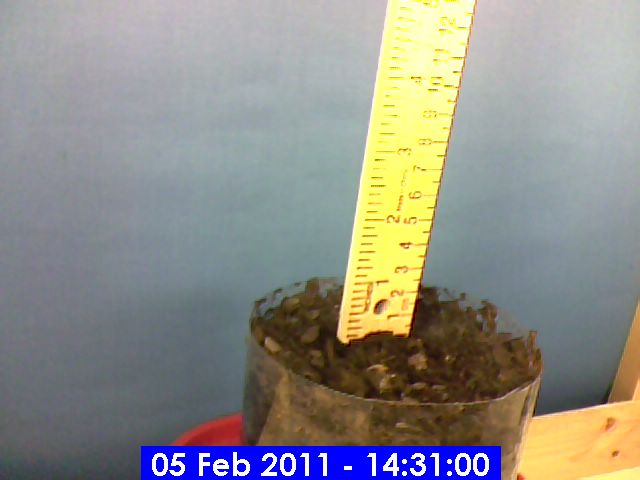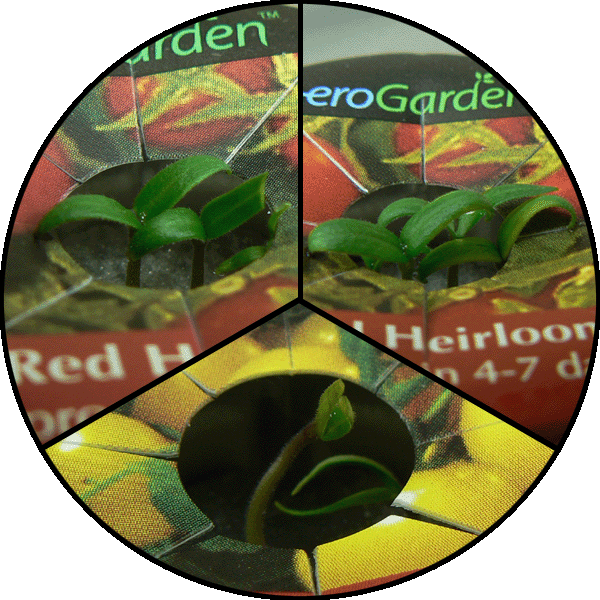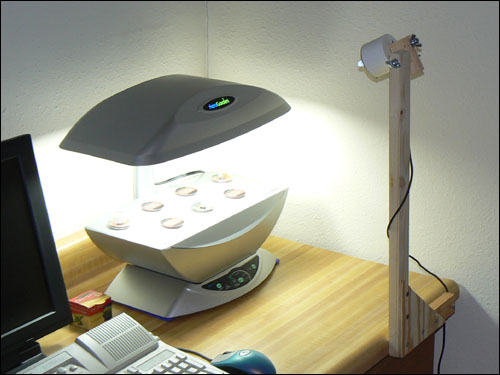 The wall on the short side of the balcony is growing in fairly well so far, and many of the vines have reached the top of their strings. I've been cutting the growing tips once they're anchored at the top, in order to encourage them to bush out, send up new growing tips, and produce thicker foliage to fill in the gaps in the wall.
The wall on the short side of the balcony is growing in fairly well so far, and many of the vines have reached the top of their strings. I've been cutting the growing tips once they're anchored at the top, in order to encourage them to bush out, send up new growing tips, and produce thicker foliage to fill in the gaps in the wall. As with last year, the Stars of Yelta have been growing vigorously, and have done a good job of populating the inside corner, where I had a problem getting a lot of coverage last year. The Mount Fuji vines on the outside corner had a bit of a head-start, having had about six weeks of growth under the lights before being transplanted out to the balcony. They quickly grew up to the top bar, and have been producing quite a few blue and white pinwheel flowers for several weeks now (the variegated leaves look great, too). the Ivy-leaved Morning Glory, Cardinal Climber, and Candy Pink vines have also been climbing well, but so far, none have produced any blooms.
As with last year, the Stars of Yelta have been growing vigorously, and have done a good job of populating the inside corner, where I had a problem getting a lot of coverage last year. The Mount Fuji vines on the outside corner had a bit of a head-start, having had about six weeks of growth under the lights before being transplanted out to the balcony. They quickly grew up to the top bar, and have been producing quite a few blue and white pinwheel flowers for several weeks now (the variegated leaves look great, too). the Ivy-leaved Morning Glory, Cardinal Climber, and Candy Pink vines have also been climbing well, but so far, none have produced any blooms.On the long edge of the balcony, all of the various types have been doing well; even the Cypress Vines, which got off to a very slow start, have started to take off. The Stars of Yelta, in the corner opposite the matching vine, have been spreading well, producing plenty of blooms, and setting seed pods. Most of the vines along this long edge of the railing have already reached the top and run for several feet along the top of the rail, so I've been cutting off the growing tips to get them to fill out (and to stop them from trying to climb up the spider plants).

 Speaking of spider plants: mine are once again in full bloom, with little plant sprouts and small white flowers all up and down the shoots. Apparently, some people haven't seen a spider plant flower before, or weren't aware that they actually do make blooms in order to reproduce from seed in addition to their usual offshoot-based propagation. Yes, they do really make flowers, which turn into seed pods. They're white, with six little petals, and are about 3/4 inch across. I've read that there can be some surprises in producing spider plants from seed; apparently, some of the "normal" varieties that people are used to are actually sports that don't actually breed true from seed. I'm not sure, as I've never actually had any spider plants that weren't direct offshoots from the same green-with-white-stripes source plant from 35 years ago.
Speaking of spider plants: mine are once again in full bloom, with little plant sprouts and small white flowers all up and down the shoots. Apparently, some people haven't seen a spider plant flower before, or weren't aware that they actually do make blooms in order to reproduce from seed in addition to their usual offshoot-based propagation. Yes, they do really make flowers, which turn into seed pods. They're white, with six little petals, and are about 3/4 inch across. I've read that there can be some surprises in producing spider plants from seed; apparently, some of the "normal" varieties that people are used to are actually sports that don't actually breed true from seed. I'm not sure, as I've never actually had any spider plants that weren't direct offshoots from the same green-with-white-stripes source plant from 35 years ago. Finally, the convolvulus plants in the hanging baskets have been growing well, and one has even started blooming. It's a white variety with a yellow throat, which is missing the "usual" blue outer edge that I'm used to seeing on these flowers. It came from a "convolvulus mix" packet, so I guess an all-white version is part of the "mix". There's also a rogue plant growing in one of the long planters along the floor, which looks suspiciously like a convolvulus plant (the leaves look about right), though I know that I didn't put any down there. Since this is the first year that I've grown convolvulus, it can't be a dropped seed from last year's experiments. It may be a weed, or it may be convolvulus. I figure I can wait a little while, and if it makes little morning-glory-like flowers on stems, I'll know that that's what it is. If not, it'll probably just be a weed, and get treated as such.
Finally, the convolvulus plants in the hanging baskets have been growing well, and one has even started blooming. It's a white variety with a yellow throat, which is missing the "usual" blue outer edge that I'm used to seeing on these flowers. It came from a "convolvulus mix" packet, so I guess an all-white version is part of the "mix". There's also a rogue plant growing in one of the long planters along the floor, which looks suspiciously like a convolvulus plant (the leaves look about right), though I know that I didn't put any down there. Since this is the first year that I've grown convolvulus, it can't be a dropped seed from last year's experiments. It may be a weed, or it may be convolvulus. I figure I can wait a little while, and if it makes little morning-glory-like flowers on stems, I'll know that that's what it is. If not, it'll probably just be a weed, and get treated as such.Indoors, the tomatoes are pretty much done doing their thing, and I'm out of nutrient pellets for the reservoir, so I'll probably be moving them and their well-developed root systems out to a soil-filled bucket outside somewhere, to see if they pick up on being outdoor tomatoes. We'll see how that works out.
 I've also been working on moving the webcams to a new computer. The one that's currently serving the images is an old mini-tower with a big processor, dual DVD burners, big graphics card, and all the power-hogging accessories that go with that sort of setup. I put a wattmeter on it, and found that it routinely pulls between 150 and 200 watts of power in the middle of the day, trying to keep itself cool. That's an awful lot of power to be burning on a machine that's running 24/7/365 and only using a fraction of its capabilities. I've built a new machine with power-efficient hardware and a minimum software install. Aside from drawing only 1/6th the power of the original machine (around 20 to 25 watts under full load), the new one is virtually silent; if not for the power LED and occasional flicker from the drive activity light, it's hard to tell if it's even turned on. It's a major improvement over the old machine, and it should have a positive impact on my electric bill.
I've also been working on moving the webcams to a new computer. The one that's currently serving the images is an old mini-tower with a big processor, dual DVD burners, big graphics card, and all the power-hogging accessories that go with that sort of setup. I put a wattmeter on it, and found that it routinely pulls between 150 and 200 watts of power in the middle of the day, trying to keep itself cool. That's an awful lot of power to be burning on a machine that's running 24/7/365 and only using a fraction of its capabilities. I've built a new machine with power-efficient hardware and a minimum software install. Aside from drawing only 1/6th the power of the original machine (around 20 to 25 watts under full load), the new one is virtually silent; if not for the power LED and occasional flicker from the drive activity light, it's hard to tell if it's even turned on. It's a major improvement over the old machine, and it should have a positive impact on my electric bill.
















